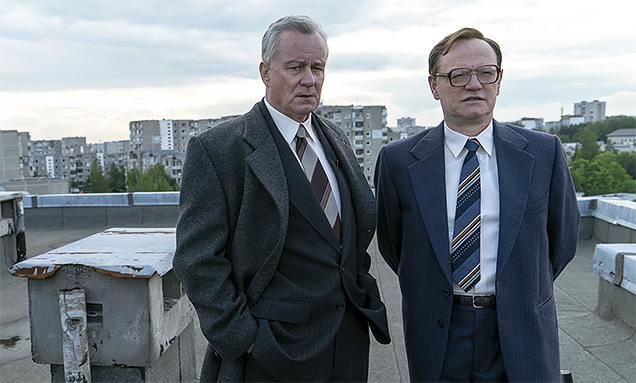The sickening greatness of Chernobyl – a perfect show for the current times

Chernobyl unexpectedly became one of the ‘must watch’ TV shows of 2019. This riveting series evokes an incredible sense of dread, writes Luke Buckmaster, and repurposes history at just the right time.
Something funny is in the air in Chernobyl, the acclaimed five part HBO miniseries that became one of the water cooler TV shows of the year. That observation applies in a literal sense, evinced in a couple of striking shots from the first episode: one of a bird dropping from the sky dead, and another of flakes of radioactive debris falling onto the faces of onlookers. These people gathered at a bridge a few miles away from the titular nuclear power plant, watching it burn, observing the pretty lights in the sky. They will suffer unimaginably for their curiosity.
No-one in this group feature in the story going forward. And yet, like a range of other fleeting encounters with random people throughout this intensely gripping series, they linger in our memories. Their lives matter. After the final episode concludes, well beyond the point at which we assumed we would not return to the lives of those people on the bridge, a text insert appears to explain that none of them survived. And that this place is now known as “The Bridge of Death.”
The idea that something funny is in the air also applies cinematically, to the series itself. What do we make of the concept of air in motion pictures? On flat two dimensional screens air does not and cannot exist. Yet often films and TV shows are discussed in relation to atmosphere, which is another way of describing air – or something very close to it. Atmosphere has a magical quality, expressed as much in images as the space between them.
Director Johan Renck does more than maintain tonal consistency across the show’s riveting five episodes. He evokes a sense of dread that feels insidious and inescapable: as if the screen were made up not of tiny pixels but pores, weeping out toxic vapor. Much power comes from the eerily crisp cinematography of Jakob Ihre, who has a striking ability to contrast human and geographical detail, and is bolstered by eerie colour grading – with various queasy shades of green and grey.
All of this is grimly appropriate to the subject matter. Chernobyl – which was created and written by Craig Mazin, who penned both sequels to The Hangover – is populated by people who are slowly being poisoned: psychologically perhaps, but especially literally. In a narrative sense the most important of these people is the protagonist Valery Legasov (Jared Harris), an atomic scientist tasked with attempting to contain the mess from the catastrophic nuclear disaster.
As Legasov states to the political apparatchik Boris Shcherbina (Stellan Skarsgård), with whom he slowly strikes up a friendship: “We are dealing with something that has never occurred on this planet before.” Legasov is perfectly played by Jared Harris, whose eyes have welled-up sorrow and whose face has a saggy kind of countenance, as if weariness of the world has pulled his skin towards the ground. He gives the impression of a person who spends a lot of time staring out windows.
Each episode explores different parts of the containment process and the Russian government’s response. The structure is journalistic, with a context-setting introductory episode then digressive tangents detailing various related issues – such as the extermination of contaminated animals, and an investigation spearheaded by Ulana Khomyuk (Emily Watson, playing a composite of scientists) into what exactly went wrong at the plant. Establishing shots, accompanied by the declaration of dates and times, are the equivalent of the top layer of journalism’s inverted pyramid: the who/what/where/when.
This is not a series that explores the old adage about how evil triumphs when good people stand by and do nothing. In Chernobyl good people do a hell of a lot, and in most instances nothing becomes of it: they work and they persevere and they suffer and they die. Generally, with some notable exceptions, they alter the state of play little or not at all, though that is not the same as saying the narrative isn’t inspiring.

The core theme is individualism equals powerlessness, but collective efforts offer hope. Renck and Mazin champion sacrificial collective action while pushing back against the system. Not through the idea that people can remove the core problem (a nuclear disaster) from existence, which is impossible, but through the pursuit of a least-worst scenario – the very idea of a “least-worst” being a terribly adult concept. It is a particularly salient message in the current moment of climate change crisis, when, as Legasov might put it, humankind is dealing with something that has never occurred on this planet before.
Is it too much to say that Chernobyl is a production fundamentally of our times? Maybe, given the nature of the present reality inevitably plays a part in colouring or even reshaping the zeitgeist. Thus in the current climate, with the environment a pressing concern, Avengers: Endgame becomes a study of population control, and Godzilla becomes the perfect symbol of our fear, guilt and anxiety.
Chernobyl is more than this: it is history being repurposed at an opportune time for the lessons of the past to resonate anew. Our best efforts might not be enough to cure the world of our worst mistakes, the message seems to be, but this effort is all that we have in terms of moral and logical outcomes. The scope and scale of the series is big, that’s for sure, but often it’s the small moments – like that scene on the bridge – that resonate the most.















